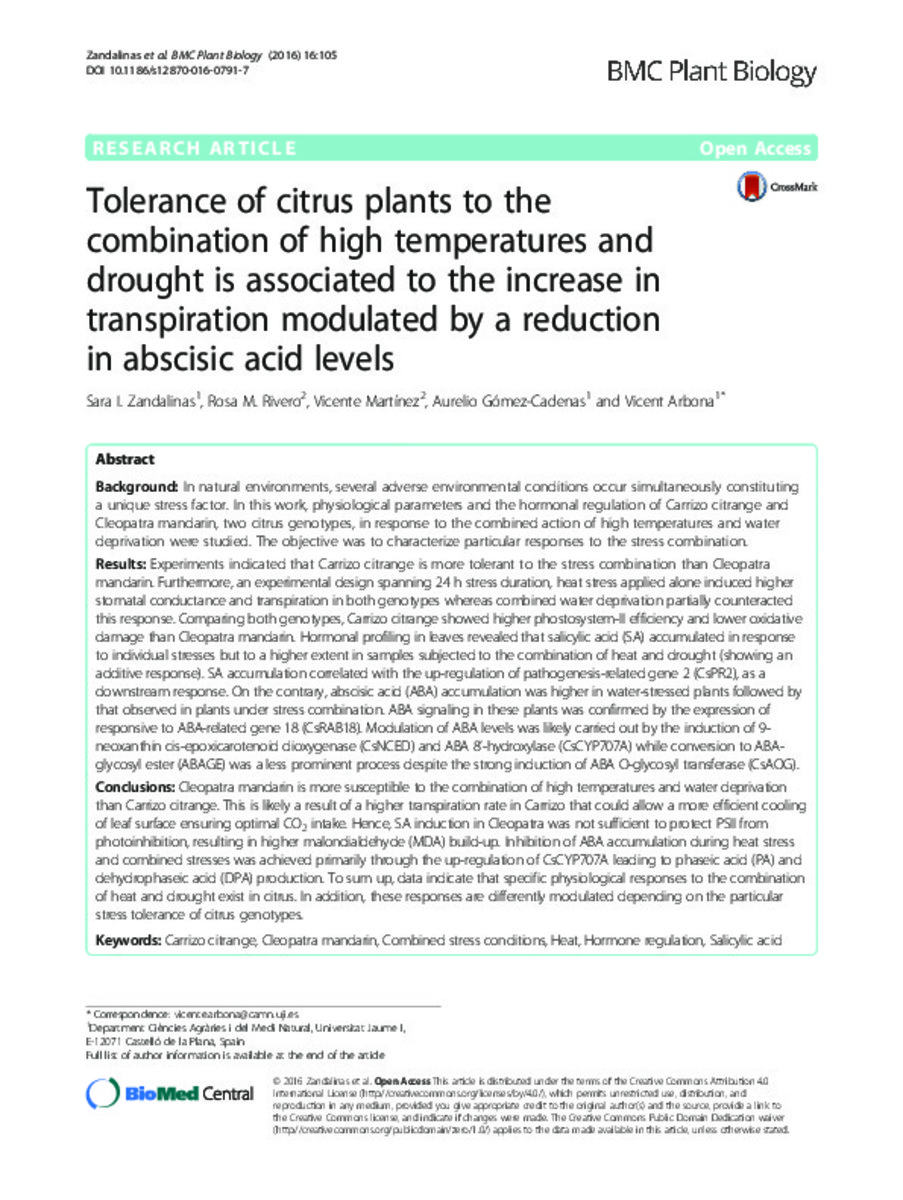Mostrar el registro sencillo del ítem
Tolerance of citrus plants to the combination of high temperatures and drought is associated to the increase in transpiration modulated by a reduction in abscisic acid levels
| dc.contributor.author | I Zandalinas, Sara | |
| dc.contributor.author | Rivero, Rosa M | |
| dc.contributor.author | Martínez, Vicente | |
| dc.contributor.author | Gomez-Cadenas, Aurelio | |
| dc.contributor.author | Arbona, Vicent | |
| dc.date.accessioned | 2017-06-27T14:49:46Z | |
| dc.date.available | 2017-06-27T14:49:46Z | |
| dc.date.issued | 2016 | |
| dc.identifier.citation | Zandalinas, S. I., Rivero, R. M., Martínez, V., Gómez-Cadenas, A., & Arbona, V. (2016). Tolerance of citrus plants to the combination of high temperatures and drought is associated to the increase in transpiration modulated by a reduction in abscisic acid levels. BMC plant biology, 16(1), 105 | ca_CA |
| dc.identifier.issn | 1471-2229 | |
| dc.identifier.uri | http://hdl.handle.net/10234/168116 | |
| dc.description.abstract | Background In natural environments, several adverse environmental conditions occur simultaneously constituting a unique stress factor. In this work, physiological parameters and the hormonal regulation of Carrizo citrange and Cleopatra mandarin, two citrus genotypes, in response to the combined action of high temperatures and water deprivation were studied. The objective was to characterize particular responses to the stress combination. Results Experiments indicated that Carrizo citrange is more tolerant to the stress combination than Cleopatra mandarin. Furthermore, an experimental design spanning 24 h stress duration, heat stress applied alone induced higher stomatal conductance and transpiration in both genotypes whereas combined water deprivation partially counteracted this response. Comparing both genotypes, Carrizo citrange showed higher phostosystem-II efficiency and lower oxidative damage than Cleopatra mandarin. Hormonal profiling in leaves revealed that salicylic acid (SA) accumulated in response to individual stresses but to a higher extent in samples subjected to the combination of heat and drought (showing an additive response). SA accumulation correlated with the up-regulation of pathogenesis-related gene 2 (CsPR2), as a downstream response. On the contrary, abscisic acid (ABA) accumulation was higher in water-stressed plants followed by that observed in plants under stress combination. ABA signaling in these plants was confirmed by the expression of responsive to ABA-related gene 18 (CsRAB18). Modulation of ABA levels was likely carried out by the induction of 9-neoxanthin cis-epoxicarotenoid dioxygenase (CsNCED) and ABA 8’-hydroxylase (CsCYP707A) while conversion to ABA-glycosyl ester (ABAGE) was a less prominent process despite the strong induction of ABA O-glycosyl transferase (CsAOG). Conclusions Cleopatra mandarin is more susceptible to the combination of high temperatures and water deprivation than Carrizo citrange. This is likely a result of a higher transpiration rate in Carrizo that could allow a more efficient cooling of leaf surface ensuring optimal CO2 intake. Hence, SA induction in Cleopatra was not sufficient to protect PSII from photoinhibition, resulting in higher malondialdehyde (MDA) build-up. Inhibition of ABA accumulation during heat stress and combined stresses was achieved primarily through the up-regulation of CsCYP707A leading to phaseic acid (PA) and dehydrophaseic acid (DPA) production. To sum up, data indicate that specific physiological responses to the combination of heat and drought exist in citrus. In addition, these responses are differently modulated depending on the particular stress tolerance of citrus genotypes. | ca_CA |
| dc.description.sponsorShip | This work was supported by Ministerio de Economía y Competitividad (MINECO) and Universitat Jaume I through grants No. AGL2013-42038-R and P1IB2013-23, respectively. SIZ was supported by a predoctoral grant from Universitat Jaume I. | ca_CA |
| dc.format.extent | 16 p. | ca_CA |
| dc.format.mimetype | application/pdf | ca_CA |
| dc.language.iso | eng | ca_CA |
| dc.publisher | BioMed Central | ca_CA |
| dc.relation.isPartOf | BMC plant biology, 2016, vol. 16, núm. 1 | ca_CA |
| dc.rights | © 2016 Zandalinas et al. Open Access This article is distributed under the terms of the Creative Commons Attribution 4.0 International License (http://creativecommons.org/licenses/by/4.0/), which permits unrestricted use, distribution, and reproduction in any medium, provided you give appropriate credit to the original author(s) and the source, provide a link to the Creative Commons license, and indicate if changes were made. The Creative Commons Public Domain Dedication waiver (http://creativecommons.org/publicdomain/zero/1.0/) applies to the data made available in this article, unless otherwise stated. | ca_CA |
| dc.rights | Atribución 4.0 Internacional | * |
| dc.rights.uri | http://creativecommons.org/licenses/by-sa/4.0/ | * |
| dc.subject | Carrizo citrange | ca_CA |
| dc.subject | Cleopatra mandarin | ca_CA |
| dc.subject | Combined stress conditions | ca_CA |
| dc.subject | Heat | ca_CA |
| dc.subject | Hormone regulation | ca_CA |
| dc.subject | Salicylic acid | ca_CA |
| dc.title | Tolerance of citrus plants to the combination of high temperatures and drought is associated to the increase in transpiration modulated by a reduction in abscisic acid levels | ca_CA |
| dc.type | info:eu-repo/semantics/article | ca_CA |
| dc.identifier.doi | https://doi.org/10.1186/s12870-016-0791-7 | |
| dc.rights.accessRights | info:eu-repo/semantics/openAccess | ca_CA |
| dc.relation.publisherVersion | https://bmcplantbiol.biomedcentral.com/articles/10.1186/s12870-016-0791-7 | ca_CA |
Ficheros en el ítem
Este ítem aparece en la(s) siguiente(s) colección(ones)
-
CAMN_Articles [566]
Excepto si se señala otra cosa, la licencia del ítem se describe como: © 2016 Zandalinas et al.
Open Access
This article is distributed under the terms of the Creative Commons Attribution 4.0
International License (http://creativecommons.org/licenses/by/4.0/), which permits unrestricted use, distribution, and
reproduction in any medium, provided you give appropriate credit to the original author(s) and the source, provide a link to
the Creative Commons license, and indicate if changes were made. The Creative Commons Public Domain Dedication waiver
(http://creativecommons.org/publicdomain/zero/1.0/) applies to the data made available in this article, unless otherwise stated.








